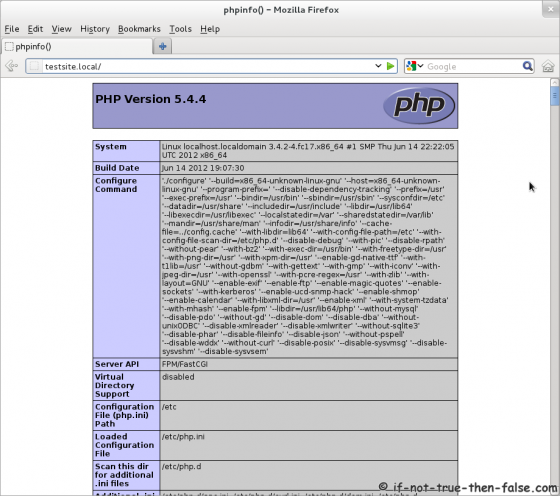I have once written Install nginx, PHP 5.3 and FastCGI on CentOS 5.5, Fedora 13, Red Hat RHEL 5.5/6 guide, but this guide is “updated” version, howto install Nginx with PHP 5.4.10 and PHP-FPM on Fedora 17/16/15/14, CentOS 6.3/6.2/6.1/6/5.8 and Red Hat (RHEL) 6.3/6.2/6.1/6/5.8. PHP-FPM is easier to use and configure than FastCGI and some tests says that PHP-FPM is even much more efficient than FastCGI.
Nginx (engine x) is a robust, small and high performance http server, reverse proxy server and also mail proxy server.
PHP-FPM (FastCGI Process Manager) is an alternative PHP FastCGI implementation with some additional features useful for sites of any size, especially busier sites.
Install Nginx, PHP 5.4.10 and PHP-FPM on Fedora 17/16/15/14, CentOS 6.3/6.2/6.1/6/5.8, Red Hat (RHEL) 6.3/6.2/6.1/6/5.8
1. Change to root user.
2. Install needed repositories
Fedora 17/16/15/14 Remi repository
## Remi Dependency on Fedora 17, 16
rpm -Uvh http://download1.rpmfusion.org/free/fedora/rpmfusion-free-release-stable.noarch.rpm
rpm -Uvh http://download1.rpmfusion.org/nonfree/fedora/rpmfusion-nonfree-release-stable.noarch.rpm
## Fedora 17 ##
rpm -Uvh http://rpms.famillecollet.com/remi-release-17.rpm
## Fedora 16 ##
rpm -Uvh http://rpms.famillecollet.com/remi-release-16.rpm
## Fedora 15 ##
rpm -Uvh http://rpms.famillecollet.com/remi-release-15.rpm
## Fedora 14 ##
rpm -Uvh http://rpms.famillecollet.com/remi-release-14.rpm
|
CentOS 6.3/6.2/6.1/6/5.8 and Red Hat (RHEL) 6.3/6.2/6.1/6/5.8 Remi repository
## Remi Dependency on CentOS 6 and Red Hat (RHEL) 6 ##
rpm -Uvh http://download.fedoraproject.org/pub/epel/6/i386/epel-release-6-7.noarch.rpm
## CentOS 6 and Red Hat (RHEL) 6 ##
rpm -Uvh http://rpms.famillecollet.com/enterprise/remi-release-6.rpm
## Remi Dependency on CentOS 5 and Red Hat (RHEL) 5 ##
rpm -Uvh http://dl.fedoraproject.org/pub/epel/5/i386/epel-release-5-4.noarch.rpm
## CentOS 5 and Red Hat (RHEL) 5 ##
rpm -Uvh http://rpms.famillecollet.com/enterprise/remi-release-5.rpm
|
CentOS 6.3/6.2/6.1/6/5.8 and Red Hat (RHEL) 6.3/6.2/6.1/6/5.8 Nginx repository
Create file /etc/yum.repos.d/nginx.repo and add following content to repo file:
CentOS
[nginx]
name=nginx repo
baseurl=http://nginx.org/packages/centos/$releasever/$basearch/
gpgcheck=0
enabled=1
|
Red Hat (RHEL)
[nginx]
name=nginx repo
baseurl=http://nginx.org/packages/rhel/$releasever/$basearch/
gpgcheck=0
enabled=1
|
3. Install Nginx, PHP 5.4.10 and PHP-FPM
Fedora 17/16/15/14, CentOS 6.3/5.8 and Red Hat (RHEL) 6.3/5.8
yum --enablerepo=remi install nginx php php-fpm php-common
|
CentOS 6.3/5.8 and Red Hat (RHEL) 6.3/5.8
yum --enablerepo=remi,remi-test install nginx php php-fpm php-common
|
4. Install PHP 5.4.10 modules
- APC (php-pecl-apc) – APC caches and optimizes PHP intermediate code
- CLI (php-cli) – Command-line interface for PHP
- PEAR (php-pear) – PHP Extension and Application Repository framework
- PDO (php-pdo) – A database access abstraction module for PHP applications
- MySQL (php-mysql) – A module for PHP applications that use MySQL databases
- PostgreSQL (php-pgsql) – A PostgreSQL database module for PHP
- MongoDB (php-pecl-mongo) – PHP MongoDB database driver
- SQLite (php-sqlite) – Extension for the SQLite V2 Embeddable SQL Database Engine
- Memcache (php-pecl-memcache) – Extension to work with the Memcached caching daemon
- Memcached (php-pecl-memcached) – Extension to work with the Memcached caching daemon
- GD (php-gd) – A module for PHP applications for using the gd graphics library
- XML (php-xml) – A module for PHP applications which use XML
- MBString (php-mbstring) – A module for PHP applications which need multi-byte string handling
- MCrypt (php-mcrypt) – Standard PHP module provides mcrypt library support
Select what you need: APC, CLI, PEAR, PDO, MySQL, PostgreSQL, MongoDB, SQLite, Memcache, Memcached, GD, MBString, MCrypt, XML
More info about PHP APC from PHP APC Configuration and Usage Tips and Tricks
Fedora 17/16/15/14
yum --enablerepo=remi install php-pecl-apc php-cli php-pear php-pdo php-mysql php-pgsql php-pecl-mongo php-sqlite php-pecl-memcache php-pecl-memcached php-gd php-mbstring php-mcrypt php-xml
|
CentOS 6.3/5.8 and Red Hat (RHEL) 6.3/5.8
yum --enablerepo=remi,remi-test install php-pecl-apc php-cli php-pear php-pdo php-mysql php-pgsql php-pecl-mongo php-sqlite php-pecl-memcache php-pecl-memcached php-gd php-mbstring php-mcrypt php-xml
|
5. Stop httpd (Apache) server, Start Nginx HTTP server and PHP-FPM (FastCGI Process Manager)
Stop httpd (Apache)
/etc/init.d/httpd stop
## OR ##
service httpd stop
|
Start Nginx
/etc/init.d/nginx start ## use restart after update
## OR ##
service nginx start ## use restart after update
|
Start PHP-FPM
/etc/init.d/php-fpm start ## use restart after update
## OR ##
service php-fpm start ## use restart after update
|
6. Autostart Nginx and PHP-FPM on boot, also prevent httpd (Apache) autostarting on boot
Prevent httpd (Apache) autostarting on boot
Autostart Nginx on boot
chkconfig --add nginx
chkconfig --levels 235 nginx on
|
Autostart PHP-FPM on boot
chkconfig --add php-fpm
chkconfig --levels 235 php-fpm on
|
7. Configure Nginx and PHP-FPM
Create directory layout for your site
I use here testsite.local site, but this could of course be your real site, like www.if-not-true-then-false.com.
## public_html directory and logs directory ##
mkdir -p /srv/www/testsite.local/public_html
mkdir /srv/www/testsite.local/logs
chown -R apache:apache /srv/www/testsite.local
|
Alternative setup to add logs under /var/log directory.
## public_html directory and logs directory ##
mkdir -p /srv/www/testsite.local/public_html
mkdir -p /var/log/nginx/testsite.local
chown -R apache:apache /srv/www/testsite.local
chown -R nginx:nginx /var/log/nginx
|
Note: I use apache user and group here, because PHP-FPM runs as apache default (apache choosed to be able to access some dir as httpd). If you use some other user on your php-fpm conf then change this accordingly.
Create and configure virtual host directories under /etc/nginx
mkdir /etc/nginx/sites-available
mkdir /etc/nginx/sites-enabled
|
Add following lines to /etc/nginx/nginx.conf file, after “include /etc/nginx/conf.d/*.conf” line (inside http block).
## Load virtual host conf files. ##
include /etc/nginx/sites-enabled/*;
|
Create testsite.local virtual host file
Add following content to /etc/nginx/sites-available/testsite.local file. This is very basic virtual host config.
server {
server_name testsite.local;
access_log /srv/www/testsite.local/logs/access.log;
error_log /srv/www/testsite.local/logs/error.log;
root /srv/www/testsite.local/public_html;
location / {
index index.html index.htm index.php;
}
location ~ \.php$ {
include /etc/nginx/fastcgi_params;
fastcgi_pass 127.0.0.1:9000;
fastcgi_index index.php;
fastcgi_param SCRIPT_FILENAME /srv/www/testsite.local/public_html$fastcgi_script_name;
}
}
|
Link your virtual host to /etc/nginx/sites-enabled
cd /etc/nginx/sites-enabled/
ln -s /etc/nginx/sites-available/testsite.local
service nginx restart
|
Add your testsite.local “domain” to /etc/hosts file
/etc/hosts file Nginx on same machine
127.0.0.1 … row should look like example following:
127.0.0.1 localhost.localdomain localhost testsite.local
|
And if you use another machine where you are running your Nginx server, then add it’s public IP as following:
Note: This is just very simple basic configuration, but if you want configure and optimize Nginx and PHP-FPM more then check following guide, Nginx and PHP-FPM Configuration and Optimizing Tips and Tricks
8. Test your Nginx and PHP-FPM setup
Create /srv/www/testsite.local/public_html/index.php file with following content:
Access following address, with your browser. http://testsite.local/

Enable Remote Connection to Nginx Web Server (Open Port 80 on Iptables Firewall)
1. Edit /etc/sysconfig/iptables file:
nano -w /etc/sysconfig/iptables
|
2. Add following line before COMMIT:
-A INPUT -m state --state NEW -m tcp -p tcp --dport 80 -j ACCEPT
|
3. Restart Iptables Firewall:
service iptables restart
## OR ##
/etc/init.d/iptables restart
|
4. Test remote connection
Access following address, with your browser. http://your.domain/


